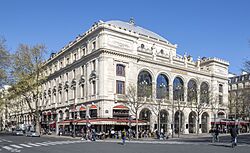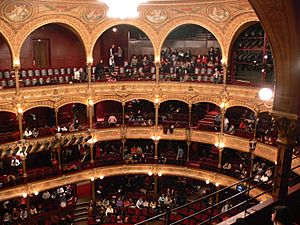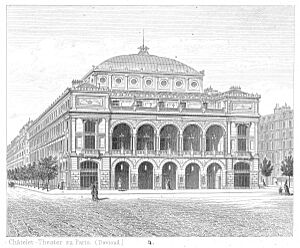Théâtre du Châtelet facts for kids
|
Théâtre Musical de Paris
|
|
 |
|
| Address | 2 rue Edouard Colonne 75001 Paris France |
|---|---|
| Coordinates | 48°51′28″N 2°20′47″E / 48.85778°N 2.34639°E |
| Public transit | |
| Owner | City of Paris |
| Capacity | 2,500 |
| Construction | |
| Opened | 1862 |
| Architect | Gabriel Davioud |
The Théâtre du Châtelet is a famous theatre and opera house in Paris, France. It's located in a busy area called the place du Châtelet.
It's one of two theatres built where a small castle, called a châtelet, once stood. The other theatre is the Théâtre de la Ville. Gabriel Davioud designed the Théâtre du Châtelet between 1860 and 1862. This was done at the request of Baron Haussmann, who was redesigning Paris.
The theatre was first called the Théâtre Impérial du Châtelet. Over the years, it has been updated and its name has changed. Today, it can seat 2,500 people.
Contents
What the Theatre Looks Like
The Théâtre du Châtelet is one of two buildings that look like twins. They stand on the banks of the Seine River, facing each other across the open Place du Châtelet. The other building is the Théâtre de la Ville.
From the outside, they both have Palladian-style entrances with arches. However, their inside layouts are quite different. In the middle of the plaza, there's a fancy fountain. It was built in 1808 to remember Napoleon's victory in Egypt.
How the Theatre Started
The Théâtre Impérial du Châtelet was built for a company that performed shows with horses, led by Hippolyte Hostein. Their old theatre was going to be torn down by Baron Haussmann. This was part of his big plan to build new streets in Paris.
The City of Paris bought the land for the new theatre in October 1859. Construction happened between 1860 and 1862. The inside was designed by Eugène Carrières and Armand Cambon. The stage curtain was made by Charles Cambon.
When it first opened, the theatre could seat 2,200 people. The types of shows allowed were set by a rule in 1862. These included military plays, fantasy shows, dramas, and light comedies.
Hippolyte Hostein stopped being the director in September 1868. Nestor Roqueplan then managed the theatre from July 1869 to April 1870.
Changes Over Time
The theatre was closed from September 1870 to July 1871 because of the Franco-Prussian War. After the war, France became a republic, and the word impérial (meaning "imperial") was removed from the theatre's name. Hippolyte Hostein returned as director in 1873–1874.
A very famous play, based on Jules Verne's Around the World in Eighty Days, started showing in April 1876. It ran for 64 years and had 2,195 performances! The show only stopped in May 1940 when Paris was occupied during World War II.
The 20th Century
In the 20th century, the theatre hosted many different kinds of performances. These included operettas, variety shows, and ballet. It also held concerts of both classical and popular music. For a while, it even became a cinema.
Many important ballets had their first performances here. These include Igor Stravinsky's Petrushka in 1911, Maurice Ravel's Daphnis et Chloé in 1912, and Erik Satie and Jean Cocteau's Parade in 1917. Famous composers and conductors like Pyotr Ilyich Tchaikovsky and Gustav Mahler also performed there.
Since 1979, the City of Paris has managed the theatre. It was greatly restored and reopened in 1980 as the Théâtre Musical de Paris. Its sound system was improved again in 1989, and it went back to being called the Théâtre du Châtelet. For a time, it was mainly used for opera and concerts. The Orchestre de Paris and the Orchestre Philharmonique de Radio France have played there. The Philharmonia Orchestra from London started playing there every year in 1993.
From 1995 to 1999, under the artistic direction of Stéphane Lissner, the theatre's sound and viewing areas were made even better.
The 21st Century
In 2004, Jean-Luc Choplin became the artistic director. He started focusing less on classical music and dance. Instead, he brought in popular Broadway musicals like Singin' in the Rain and 42nd Street.
In 2017, Ruth Mackenzie took over as artistic director. She wanted the theatre's shows to connect more with the people of Paris, including those from the surrounding areas. From 2017 to 2019, the theatre was closed for a big renovation. The main goal was to update the electrical systems and fire safety. The main hall was also restored to how it looked in 1862. Statues that had been removed in the late 1800s were put back outside the theatre.
When the theatre reopened in 2019, Mackenzie and Thomas Lauriot dit Prévost started a "Robin Hood scheme." This allowed theatregoers and sponsors to buy extra tickets for people who couldn't afford them.
In 2019, the fashion brand Comme des Garçons launched a perfume inspired by the theatre's history.
Since 2019, the ceremony for the Ballon d'Or award, which honors the best football players, has been held at the Théâtre du Châtelet every year.
In August 2020, Ruth Mackenzie left her role as artistic director. Thomas Lauriot dit Prévost remained as the general director.
Between September 2020 and January 2022, many shows were canceled due to the coronavirus pandemic.
In February 2022, 32 dancers from the Kyiv City Ballet were in Paris when the Russian invasion of Ukraine began. The City of Paris offered them a place to stay and perform at the Théâtre du Châtelet. The mayor of Paris, Anne Hidalgo, announced this arrangement, saying it would last "for as long as it takes."
See also
 In Spanish: Teatro del Châtelet para niños
In Spanish: Teatro del Châtelet para niños



